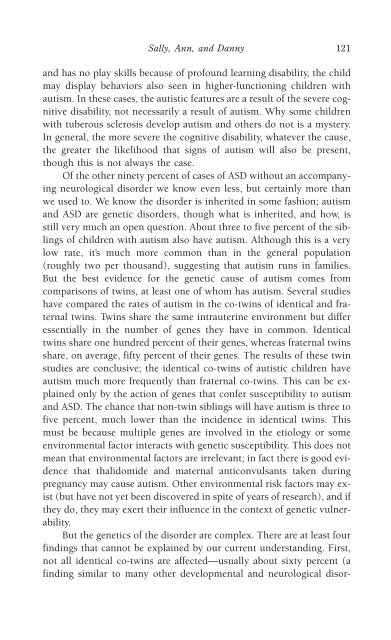978-1572305441
autism
autism
You also want an ePaper? Increase the reach of your titles
YUMPU automatically turns print PDFs into web optimized ePapers that Google loves.
Sally, Ann, and Danny 121<br />
and has no play skills because of profound learning disability, the child<br />
may display behaviors also seen in higher-functioning children with<br />
autism. In these cases, the autistic features are a result of the severe cognitive<br />
disability, not necessarily a result of autism. Why some children<br />
with tuberous sclerosis develop autism and others do not is a mystery.<br />
In general, the more severe the cognitive disability, whatever the cause,<br />
the greater the likelihood that signs of autism will also be present,<br />
though this is not always the case.<br />
Of the other ninety percent of cases of ASD without an accompanying<br />
neurological disorder we know even less, but certainly more than<br />
we used to. We know the disorder is inherited in some fashion; autism<br />
and ASD are genetic disorders, though what is inherited, and how, is<br />
still very much an open question. About three to five percent of the siblings<br />
of children with autism also have autism. Although this is a very<br />
low rate, it’s much more common than in the general population<br />
(roughly two per thousand), suggesting that autism runs in families.<br />
But the best evidence for the genetic cause of autism comes from<br />
comparisons of twins, at least one of whom has autism. Several studies<br />
have compared the rates of autism in the co-twins of identical and fraternal<br />
twins. Twins share the same intrauterine environment but differ<br />
essentially in the number of genes they have in common. Identical<br />
twins share one hundred percent of their genes, whereas fraternal twins<br />
share, on average, fifty percent of their genes. The results of these twin<br />
studies are conclusive; the identical co-twins of autistic children have<br />
autism much more frequently than fraternal co-twins. This can be explained<br />
only by the action of genes that confer susceptibility to autism<br />
and ASD. The chance that non-twin siblings will have autism is three to<br />
five percent, much lower than the incidence in identical twins. This<br />
must be because multiple genes are involved in the etiology or some<br />
environmental factor interacts with genetic susceptibility. This does not<br />
mean that environmental factors are irrelevant; in fact there is good evidence<br />
that thalidomide and maternal anticonvulsants taken during<br />
pregnancy may cause autism. Other environmental risk factors may exist<br />
(but have not yet been discovered in spite of years of research), and if<br />
they do, they may exert their influence in the context of genetic vulnerability.<br />
But the genetics of the disorder are complex. There are at least four<br />
findings that cannot be explained by our current understanding. First,<br />
not all identical co-twins are affected—usually about sixty percent (a<br />
finding similar to many other developmental and neurological disor-



